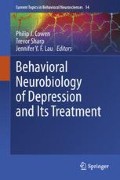Abstract
The classification of depression is well established in major diagnostic systems and operational definitions now make the diagnosis of depression reasonably reliable. However, classification and diagnosis continue to be based on clinical presentation and course and are not currently informed by aetiological or pathophysiological considerations. It is still unclear, for example, whether or not categories such as melancholic depression represent distinct subforms of illness or whether a dimensional classification based on severity can capture clinical presentation adequately and more economically. Despite these caveats, there is some evidence that distinctions between various subforms of depression can predict treatment response and this can be useful for clinical practice as well as guiding research strategies.
Access this chapter
Tax calculation will be finalised at checkout
Purchases are for personal use only
References
Akiskal HS (2009) Dysthymia, cyclothmia and hyperthymia. In: Gelder MG, Andreasen NC, Geddes JR (eds) New oxford textbook of psychiatry. Oxford University Press, Oxford, pp 680–691
American Psychiatric Association (1994) Diagnostic and statistical manual of mental disorders, 4th edn. American Psychiatric Association, Washington
Angst J (2009) Course and prognosis of mood disorders. In: Gelder MG, Andreasen NC, Geddes JR (eds) New oxford textbook of psychiatry. Oxford University Press, Oxford, pp 665–669
Broadhead WE, Blazer DG, George LK et al (1990) Depression, disability days, and days lost from work in a prospective epidemiologic survey. JAMA 264:2524–2528
Coryell W (2007) The facets of melancholia. Acta Psychiatr Scand 115:31–36
Cowen PJ, Harrison PJ, Burns T (2012) Shorter Oxford Textbook of Psychiatry, Ch 11, Mood disorders. Oxford University Press, Oxford
Eagles JM (2003) Seasonal affective disorder. Br J Psychiatry 182:174–176
Forty L, Smith D, Jones I et al (2008) Clinical differences between bipolar and unipolar depression. Br J Psychiatry 192:388–389
Goodwin GM (2009) Evidence-based guidelines for treating bipolar disorder: recommendations from the British association for psychopharmacology. J Psychopharmacol 23:346–388
Horder J, Matthews P, Waldmann R (2011) Placebo, prozac and PloS: significant lessons for psychopharmacology. J Psychopharmacol 25:1277–1288
Horwitz AV, Wakefield JC (2007) The loss of sadness: how psychiatry transformed normal sorrow into depressive disorder. Oxford University Press, Oxford
Joyce PR (2009) Epidemiology of mood disorders. In: Gelder MG, Andreasen NC, Lopez-Ibor JJ, Geddes JR (eds) New Oxford Textbook of Psychiatry. Oxford University Press, Oxford, pp 645–650
Kendler KS (1997) The diagnostic validity of melancholic major depression in a population-based sample of female twins. Arch Gen Psychiatry 54:299–304
Lima MS, Moncrieff J (2000) Drugs verses placebo for dysthymia. Cochrane Database Syst Rev 4:CD001130
Maj M (2011) When does depression become a mental disorder? Br J Psychiatry 199:85–86
McManus S, Meltzer H, Brugha TS et al (2007) Adult psychiatric morbidity in England: results of a household survey. The NHS Information Centre for Health and Social Care, Leeds
Parker G (2009) Diagnosis, classification and differential diagnosis of mood disorders. In: Gelder MG, Andreason NC, Lopez-Ibor JJ, Geddes JR (eds) New oxford textbook of psychiatry. Oxford University Press, Oxford, pp 637–645
Pezawas L, Wittchen HU, Fister H et al (2003) Recurrent brief depressive disorder reinvestigated: a community sample of adolescents and young adults. Arch Gen Psychiatry 33:407–418
Shelton RC, Tomarken AJ (2001) Can recovery from depression be achieved? Psychiatr Serv 52:1469–1478
Spiker DG, Cofsky Weiss J, Dealey RS et al (1985) The pharmacological treatment of delusional depression. Am J Psychiatry 142:430–436
Stewart JW, McGraith PJ, Quitkin FM et al (2009) DSM-1V depression with atypical features: is it valid. Neuropsychopharmacology 34:2625–2632
Wijikstra J, Burger H, Van den Broek WW et al (2010) Treatment of unipolar psychotic depression: a randomized double-blind study comparing imipramine, venlafaxine and venlafaxine plus quetiapine. Acta Psychiatr Scand 121:190–200
World Health Organization (1992) The ICD-10 classification of mental and behavioural disorders-clinical descriptions and diagnostic guidelines. World Health Organisation, Geneva
Author information
Authors and Affiliations
Corresponding author
Editor information
Editors and Affiliations
Rights and permissions
Copyright information
© 2012 Springer-Verlag Berlin Heidelberg
About this chapter
Cite this chapter
Cowen, P.J. (2012). Classification of Depressive Disorders. In: Cowen, P., Sharp, T., Lau, J. (eds) Behavioral Neurobiology of Depression and Its Treatment. Current Topics in Behavioral Neurosciences, vol 14. Springer, Berlin, Heidelberg. https://doi.org/10.1007/7854_2012_218
Download citation
DOI: https://doi.org/10.1007/7854_2012_218
Published:
Publisher Name: Springer, Berlin, Heidelberg
Print ISBN: 978-3-642-35424-3
Online ISBN: 978-3-642-35425-0
eBook Packages: Biomedical and Life SciencesBiomedical and Life Sciences (R0)

